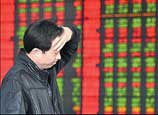
China's GDP increased by 4.78 trillion yuan year-on-year to 51.93 trillion yuan in 2012, with consumption, investment and net exports contributing 51.8 percent, 50.4 percent and negative 2.2 percent to the GDP respectively, according to figures from the National Bureau of Statistics (NBS).
Some people believe the negative net exports contribution means foreign trade dragged down the economic growth. Is it right or not?
According to economic theory, a country's GDP consists of total investment, consumption and net exports (including exports of goods and services). Net exports are the difference between the total value of exports and that of imports; its contribution to economic growth is the ratio between increase of net exports and that of GDP.
Yu Miaojie, associate professor at Peking University's national development research institute, said negative net exports only mean the increased volume of net exports, or trade surplus, are less than that of the previous year, which is almost not related to the economic growth.
The NBS data showed that from 2008 to 2012, the contribution of net exports to economic growth varied from 9 percent to negative 44.8 percent, while GDP growth rate during this period all exceeded seven percent, which means the fluctuations of net exports did not cause the China's economic fluctuations. It only has close relation with the trend of China's foreign trade.
In 2008, China's exports hit record high and imports growth was relatively slow; the net exports contribution to economic growth reached nine percent.
In 2009, China's trade surplus was significantly less than that of 2008 amid weak external demand caused by global financial crisis. Net exports contribution to economic growth amounted to 7.9 percent.
In 2011, the export situation was generally stable, but imports picked up quickly, and net exports contribution stood at negative 5.8 percent. In 2012, the figure reached negative 2.2 percent.
Negative net exports do not mean foreign trade dragged down economic growth, according an official from the Ministry of Commerce.
The official said promoting open economy is the engine for China's economic development and industrial upgrading. With the increasing balance between imports and exports, trade surplus will further reduce. So the decreasing or negative net exports contribution to GDP will become normal.
Foreign trade plays an irreplaceable role
Huo Jianguo, director general of the International Trade and Economic Cooperation Research Institute of the Ministry of Commerce, believed that net exports contribution reflects the relations among consumption, investment and net export, not referring to the actual contribution of a certain category of economic growth. These three are closely related. Exports directly increase the foreign demand for domestic goods and services, and imports, not replacing domestic production, often provide goods and services that lack in domestic market.
Actually, using net exports to measure its contribution to economic growth will underestimate foreign trade's role. If the value of imports and exports is high, but trade surplus is low, then the added value, such as employment and services, brought by trade activities, could not be reflected by net exports contribution, though foreign trade plays a significant role for economic growth.
Long Guoqiang, director of Foreign Ministry of Economic Affairs under Development Research Centre of State Council, said by participating in foreign trade and international division of labor, countries can develop its own comparative advantages, improve efficiency of resource allocation, expand employment, increase resident income and promote upgrading of industrial structure.
In the case of developed countries, the average contribution rate of U.S. net exports to economic growth is minus 11 percent. Is the foreign trade a burden for U.S. economy? The answer is no.
Just the reverse, the United States has utilized international trade to import a large number of labor-intensive products and resource products from developing countries, which has saved hundreds of billions of U.S. dollars for its consumers every year.

Read the Chinese version: 外贸拖没拖经济后腿(经济热点)
Source: People's Daily; Author: Du Haitao and Wang Ke
















 Seeking a dream wedding at Beijing Wedding Expo
Seeking a dream wedding at Beijing Wedding Expo


![]()
